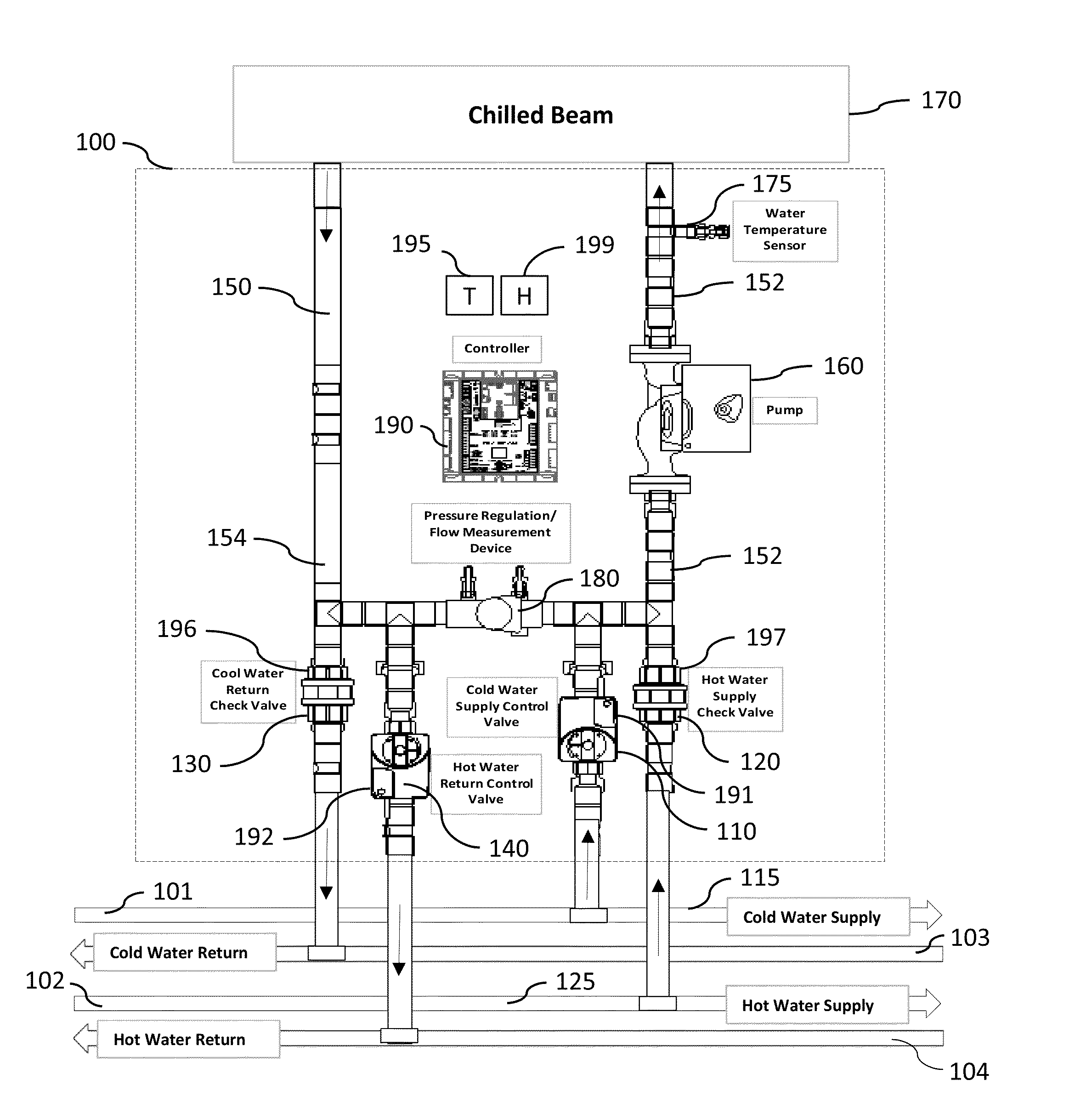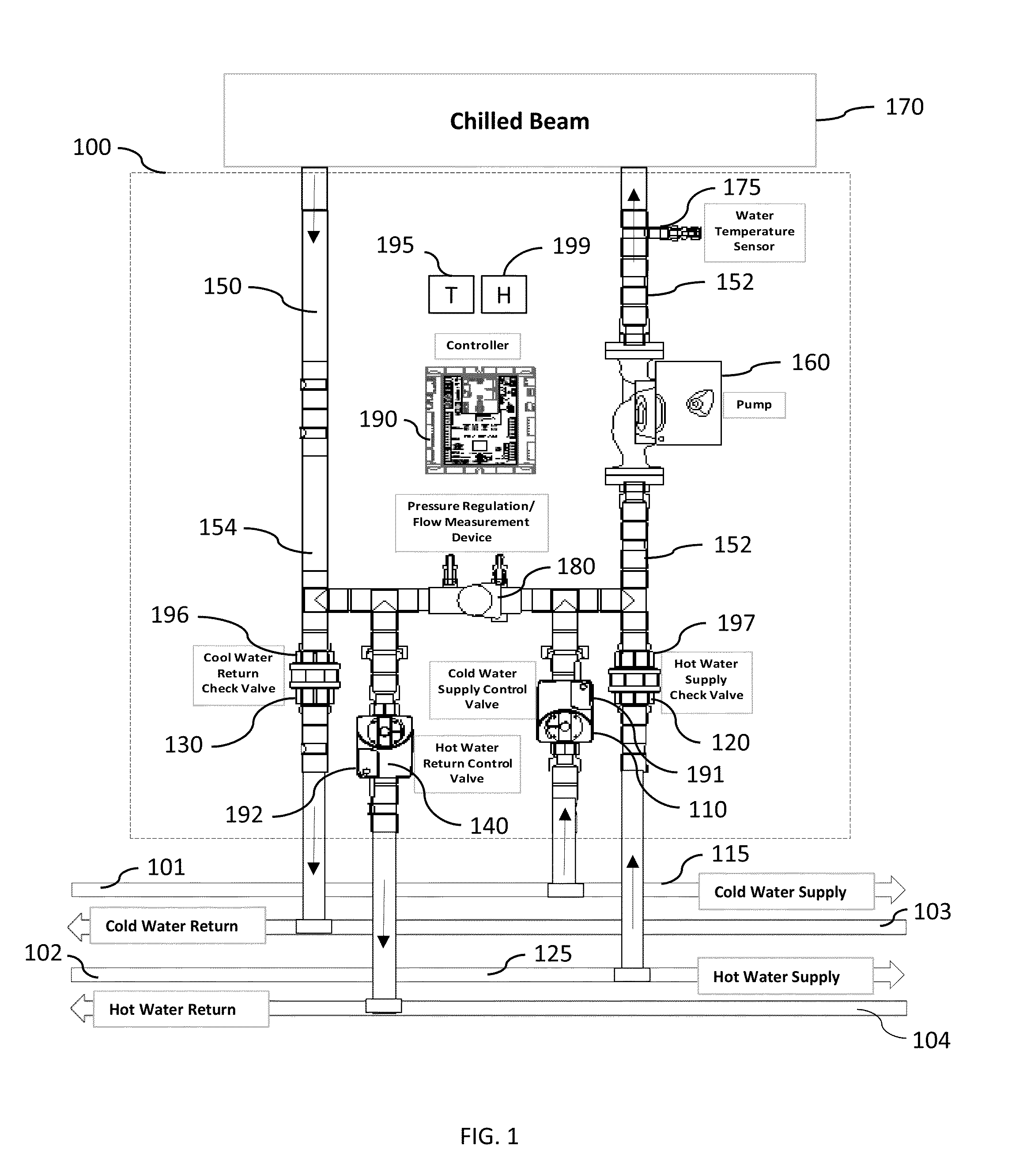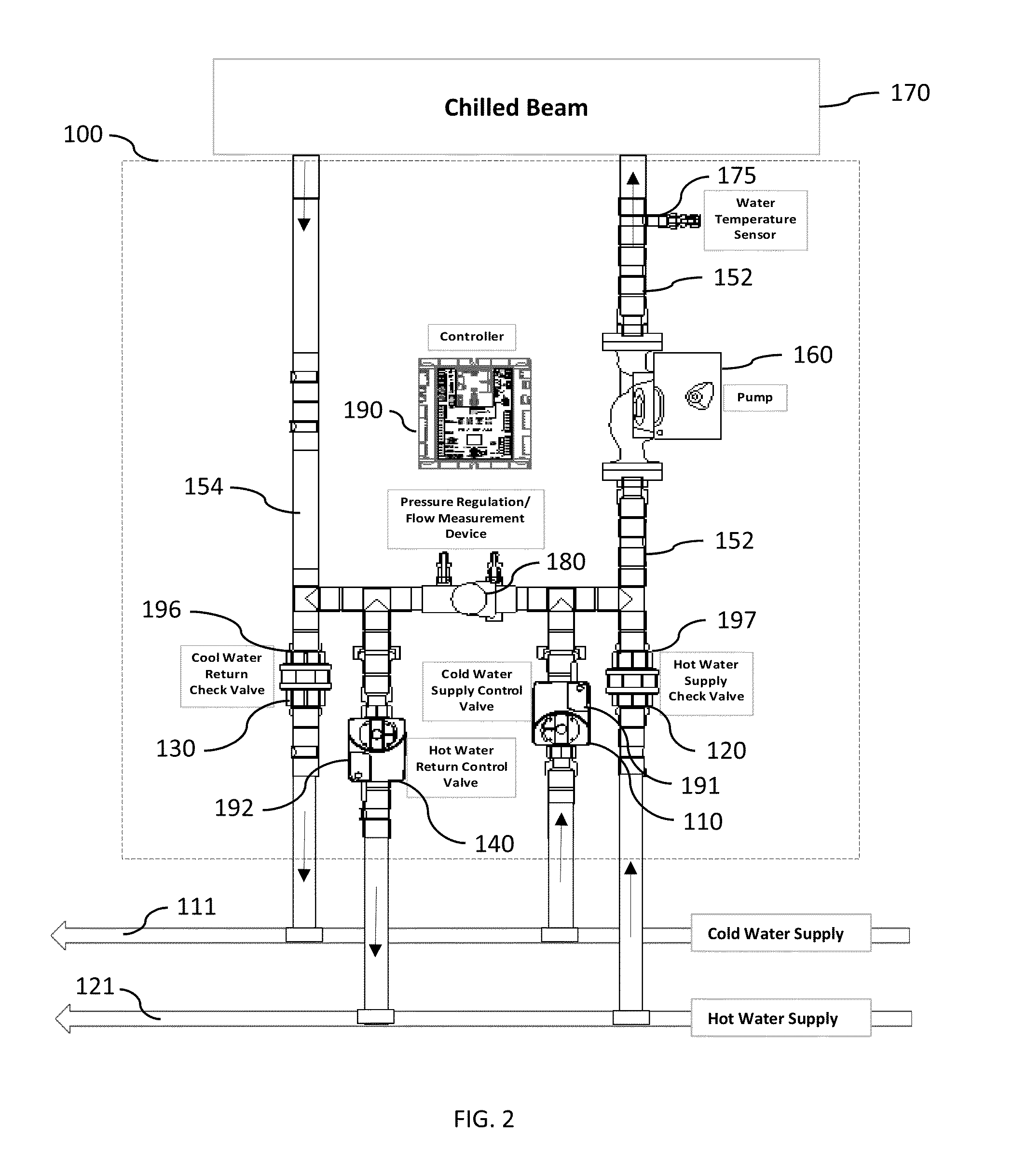Passive beams, on the other hand, do not have air connections, and thereby do not deliver nor induce
airflow.
A common feature of typical active and passive chilled beams that both cool and heat is that they require chilled or hot water to be passed through the device to function, involve a significant amount of costly chilled and hot water
piping, require careful control over the
chilled water temperature, and air flow serving the beams and the space served by the beams must be effectively dehumidified to avoid condensation.
Typical heating loop water temperatures (say 140 degrees F.) should not be provided to the beams when in heating mode, in many applications, since the low velocity air leaving the beams can result in stratification which compromises both comfort of the occupants and the
heating efficiency of the coils in the heating beams.
While effective, there are a number of limitations and problems with the current state-of-the-art chilled-
beam system design.
Some of these limitations are considered major barriers by many
engineering design firms, causing them to continue the use less energy efficient conventional
HVAC systems.
This duplication of water loops and associated cost has proven to be a significant barrier to acceptance and use of chilled-beam technology.
Second, in many applications, the greatest incremental cost of a chilled-
beam system is the material and installation cost associated with the water
piping.
Since the current state-of-the-art chilled-
beam system design involves both a supply and return
piping network throughout the building for each of the hot and cold water lines, and these four runs of distribution piping commonly are
copper, the cost is considerable.
Adding to the problem of high cost associated with the current approach, the size /
diameter of the
pipe must be relatively large to accommodate the high water flows associated with the moderate chilled and hot water temperatures required by the beams.
This high cost of chilled and hot water piping has proven to be a barrier to acceptance and use of chilled-beam technology.
Further, the use of a single pump to provide water to all zones can be both limiting and problematic.
Another common problem is that the installation of the piping and valves, due to jobsite limitations, is often less than ideal (e.g., more bends and turns than the original design) which adds pressure loss to the
system which must be overcome by the main pump.
The main pump may not have the capacity to increase the pressure through the entire
system to accommodate the
peak load in a problematic zone or zones that need additional cooling.
Another challenge is that much of the pressure loss within the main chilled beam distribution piping can occur between the main supply water distribution
pipe and the main return
water pipe.
In many cases, the pipe connecting the beams to the main water lines is done in flexible PEX type tubing using special connectors that reduce installation labor but often increase the pressure loss through the system.
Yet another limitation is that the
water flow to each zone has to be measured and balanced so that the chilled beams get the
design flow of water in both the heating and cooling
modes.
In cases where the system efficiency could benefit from a variation, however, either up or down, of the
water flow to the beams, for either efficiency reasons or capacity boost, this can not be accomplished with the prior art design approach.
This concern regarding how to increase the heating or
cooling capacity at the zone at the end of the piping system has proven to be a barrier to acceptance and use of chilled-beam technology.
Fourth, perhaps the most significant barrier to acceptance of the chilled-beam technology in moderately or severely
hot and humid climates, commonplace in the US and Asia, is the concern for condensation on the beams.
While there are many advantages to operating chilled beams as sensible-only devices, should condensation occur, allowing water to drip directly into the occupied space, it would be a very serious problem in most applications and is typically unacceptable.
Design errors can occur, however.
In all these cases, condensation could occur.
While, when working properly, this approach can provide a level of protection against dripping water from the beams into the occupied space, it immediately cuts all cooling provided by the chilled beams to the occupied space, which is often not acceptable to the users of the space nor considered an acceptable solution by many design engineers.
This concern regarding condensation on the beams and how to avoid eliminating cooling in response to a condensation
signal has proven to be a barrier to acceptance and use of chilled-beam technology.
There are few viable options to make up for this loss of performance.
The primary
airflow can be increased to provide more cooling associated with the air delivered to the room, but this is a costly solution since it involves both fan energy and more conditioning at the DOAS.
Lowering the
water temperature would provide added cooling output, but doing so increases the risk of condensation at the beams and, with the state-of-the-art design, means that this lower
water temperature is provided to all zones.
Increasing the
beam length is the best option with regard to energy efficiency, but the cost of each beam would be increased by 15% to 25% and there is a practical limit to how much ceiling area can be allocated for the beams since light fixtures typically must also be effectively accommodated.
In addition to the higher cost associated with increasing the length of the beam, there is also a significant cost associated with changing the coil to allow for both heating and cooling.
As a result, very little flexibility is provided to accommodate varying load conditions.
For example, should a room experience a heat
gain that is greater than design due to increased occupancy, higher than anticipated solar load or degradation to the chilled or hot water temperature, there is no way for the system to respond.
Once opened, the maximum cooling or heating capacity is recognized and there is no way to deliver more.
While this addresses the lower cooling requirement, it does so in a way that does not efficiently use pump energy and there can be more frequent than desired swings in
room temperature.
There have also been complaints of nuisance
noise associated with the
control valves turning on and off associated with the initial in-rush of
high pressure water.
Since chilled beams are otherwise a very quite technology, this
noise is easily detected and is not easily remedied.
This can be problematic, however, if the
control system uses a night setback temperature that requires a rapid
morning warm up mode (i.e., higher heating output on a temporary basis).
A similar problem exists during unusually cold days when the envelope
heat losses from the building are greater than design.
Likewise, since the building is unoccupied, the amount of heat normally generated by the lights and people is removed from the space, so only a small fraction of the peak cooling output from the beams is required.
While the
potential energy savings are significant, the VAV enhancement presents serious challenges to the current chilled-beam system design approach.
As mentioned, if the
airflow reduction is too low to
handle the space latent load, the space
dew point may
climb causing condensation on the beams.
As a result, the rooms could remain without cooling for extended periods making it difficult to cool them back down in a timely manner, for example, the next
morning.
At times like this, there may not be adequate
cooling capacity delivered by the beams.
If the room gets too hot, there is no way for the prior art design to respond.
Nor does it allow for optimization of the overall system.
 Login to View More
Login to View More  Login to View More
Login to View More 


